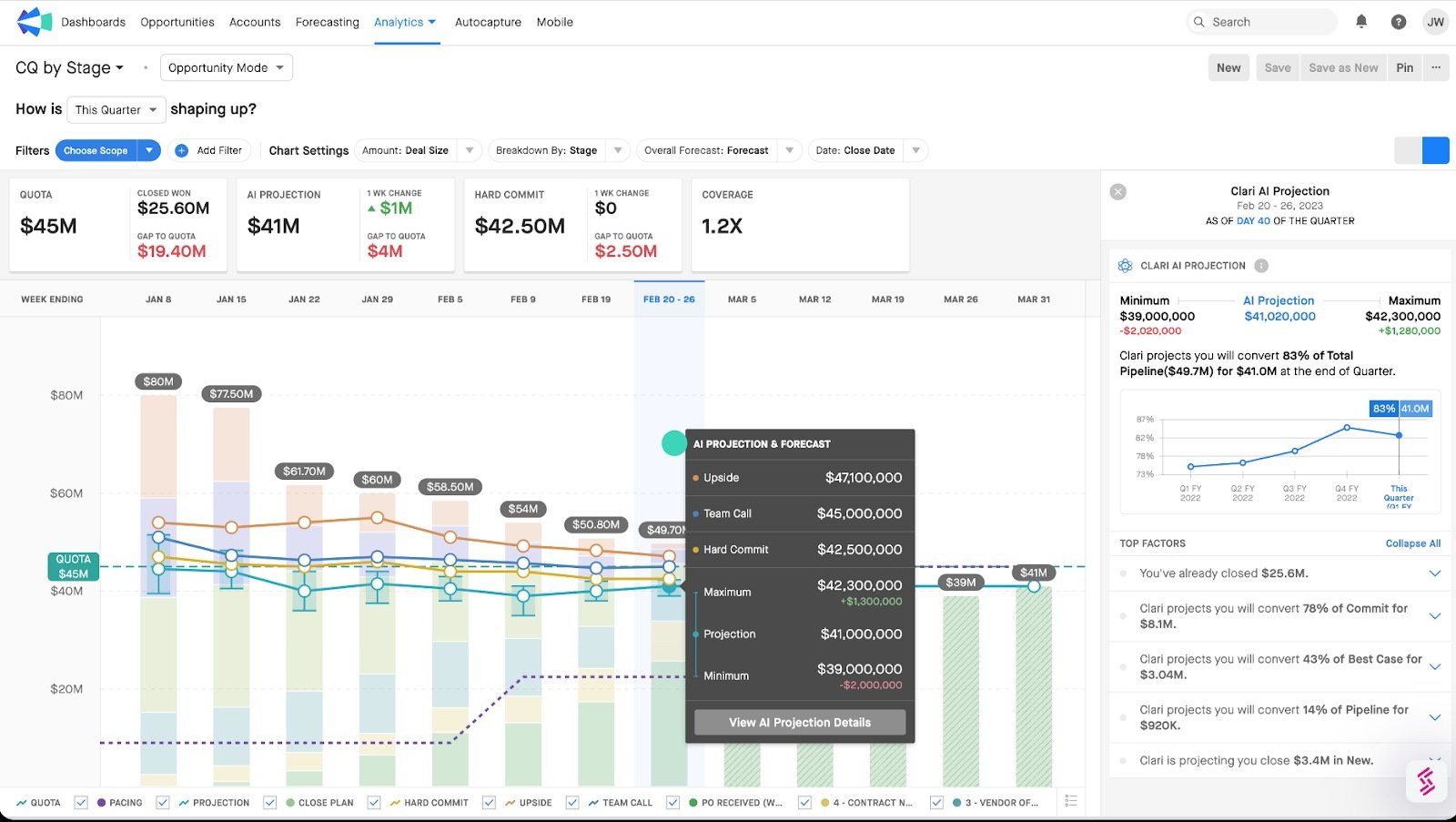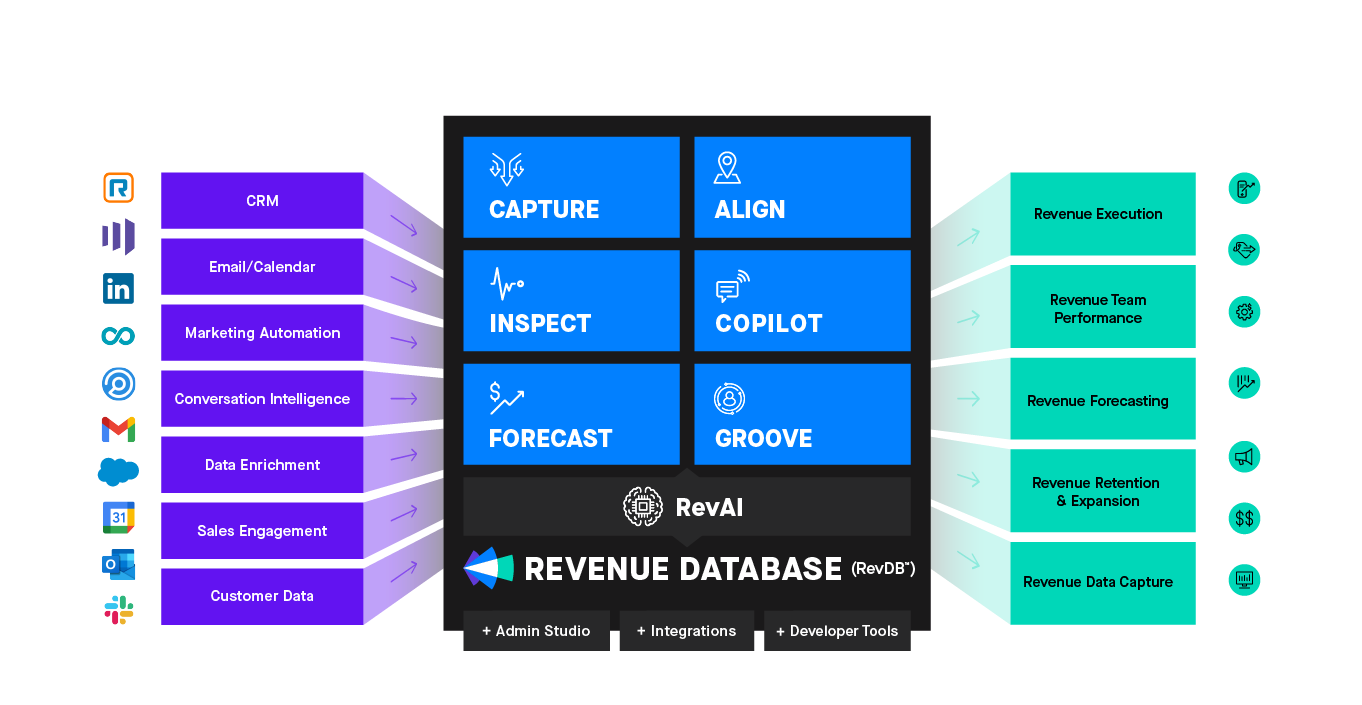When planning future sales or marketing efforts, you need reliable estimates of your sales numbers.
Revenue projections and revenue forecasts are two different approaches that can help you achieve this. However, their methods and applications are quite different. How do you know which one is right for you?
That’s what we’re going to explore in this comparison article. We break down exactly what revenue projections and forecasts are, highlight key differences, and cover the best forecasting methods for go-to-market teams in 2024.
Table of contents:
- What are revenue projections?
- What are revenue forecasts?
- 3 key differences between revenue projections vs. forecasts
- When should you use revenue projections vs. revenue forecasts?
- Get more accurate revenue projections and forecasts with AI and broader data
- Use other smart tools like deal scoring to help your reps close more deals
What are revenue projections?
Revenue projections are a company’s estimated earnings for a given period. They’re often influenced heavily by sales goals, not just industry trends and sales performance data.
Projections usually outline an estimate of specific sales numbers weekly, monthly, or quarterly for up to a year or more. Considered factors include:
- Current sales numbers
- Seasonal trends and their typical influence on sales
- Larger market trends
- Last year’s sales performance in similar periods
B2B sales teams will also consider:
- The number of potential deals in the sales pipeline
- Sales velocity and other sales performance metrics
Revenue projection example
Here’s an example of a typical sales projection for 12 months based on data from previous years and the months leading up to it.

But for subscription-based businesses, this won’t represent revenue or profits accurately. Instead, revenue projections are better tools for planning future efforts and campaigns. They can give you holistic insights that more accurately predict your financial performance.
After all, the percentage of “old” annual recurring revenue in SaaS companies ranges from 29–53% of all revenue. That’s recurring revenue you keep with no new sales efforts. So, just focusing on new sales is a mistake.
You need an overview of recurring revenue and sales to project revenue accurately. The best way to achieve this is to align go-to-market teams through revenue operations (RevOps).
To combine recurring revenue and estimated new revenue into a single projection, follow these steps:
- Take your annual recurring revenue estimates
- Adjust for churn rates
- Combine the numbers with your sales projections
Of course, this is a lot easier said than done. Nobody wants to spend hours doing spreadsheet data entry to combine the data sets. That’s why many revenue and financial planning teams rely on revenue platforms to do this for them.
What are revenue forecasts?
A sales forecast is a prediction based on specific sales performance data, like the number of deals in the pipeline, their estimated sizes, and the previous quarterly sales numbers.
A revenue forecast also takes recurring revenue and other go-to-market factors into consideration. For example, it can use data from marketing campaigns to estimate sales performance.
Of course, the problem with adding more data sources is that it adds more complexity. It’s almost impossible to analyze all of this data manually. Savvy revenue leaders understand this and have started adapting AI's power for this purpose.
Revenue forecast example
We could give another spreadsheet-based example, but it wouldn’t represent reality. In recent years, many companies have adopted AI-powered revenue operations to boost forecasting accuracy.
By integrating data from multiple go-to-market teams, you can forecast recurring revenue from existing clients and likely acquisition numbers from marketing and sales.
Here’s an example of what this looks like inside Clari:

You can see the AI projection for sales compared to the sales quota set for the quarter. You can also break down the deals by their conversion likelihood and other factors.
Here are a few of the sales projection metrics you can work with:
- Quota attainment (both in general and for specific reps)
- Pipeline coverage — the total amount of sales opportunities versus your quota
- Historical conversions and sales velocity
- Sales activity data — how many calls, emails, and other actions your reps take
This new level of oversight makes it easy to plan for various potential outcomes. You can adjust the model based on various levels of optimism to prepare emergency plans.
These metrics, the adaptability, and the wide data set make these forecasts much more reliable than traditional ones. (This is the main reason why AI-powered forecasts represent the future of sales forecasting).
But tools alone won’t help you accurately predict future revenue. If you want more in-depth info, check out our guide on 12 different sales forecasting methods and how to use them.
3 key differences between revenue projections vs. forecasts
While there are subtle differences between sales and revenue projections and forecasts, they’re not critical differences — the terms are often used interchangeably, even by experienced revenue professionals.
However, there are a few distinct differences in how most experts talk and think about forecasts vs. projections.
Revenue projections usually focus on long-term planning
Revenue projections usually focus on longer-term planning, typically a year or multiple years.

A longer period will naturally change the character of the projections. You cannot approach a 12-month projection in the same way as a single-quarter forecast. Even if you focus on a few key metrics, you won’t have reliable data to cover the entire period.
That often means relying on sales quotas and historical performance.
Revenue projections are usually more adaptable
You must account for future conditions because projections focus on the longer term. Experienced revenue leaders account for this by setting realistic goals and leaving room for change.
We’re not saying you shouldn’t aim high with your sales quotas. But they must reflect reality — like the number of deals in the pipeline and the MQLs that come in every month.
Creating multiple projections by varying key metrics is the best way to ensure adaptability. For example, you can adjust the average deal size or expected conversion rates. You can create three different patterns:
- An optimistic projection
- A pessimistic projection
- And a realistic projection
(Modern revenue platforms like Clari let you adjust projections in this way with a few clicks).
Sales forecasts focus on hard data to make more reliable short-term predictions
Sales forecasts usually focus on a shorter term, like a quarter, and stick to hard data when possible. They look at the deals in the pipeline, how they’re progressing, and their potential deal sizes.
To help ensure forecasts represent reality, savvy revenue teams hold weekly sales forecast calls. This has several benefits:
- Marketing teams stay updated on priority accounts to target with campaigns.
- Sales leaders get updated on key marketing campaign trends.
- Finance teams get visibility of expected revenues, allowing them to plan for investments.
Accurate forecasts require the close collaboration of all go-to-market teams. If you want your reps to work based on hard data, transitioning to RevOps is the first step.
When should you use revenue projections vs. revenue forecasts?
Traditionally, rough projections were used for long-term planning, while forecasts were used for shorter-term planning (like adapting quarterly sales goals).
You’d use sales forecasts for:
- Adapting quarterly revenue goals
- Making short-term sales hiring decisions
- Adapting short-term marketing efforts and budget
You’d use sales projections for:
- Annual or multi-year planning
- Comparing hypothetical scenarios

But there’s an elephant in the room. The way most companies used to do their sales forecasts is mostly guesswork. They didn’t use enough data points to get reliable predictions.
As a result, only 45% of sales leaders and sellers in 2020 felt confident in their sales projections.
However, breakthroughs in AI over the past few years have led to improved accuracy in predictive analytics. That means most companies will be better off with an AI-powered approach.
Instead of manually digging through the data, you rely on AI to determine future trends. Forecasting this way is not just less work. It’s also more accurate.
Get more accurate revenue projections and forecasts with AI and broader data
With the right tools and approach, AI can play a crucial role in forecasting your sales accurately. But you need the right tools and foundation for that to happen.
Here’s how to get started in the right direction.
Start by unifying go-to-market teams through revenue operations
If you only have data points from sales, like your sales CRM, you won’t be able to forecast revenue accurately.
So, the first step is to unify all your go-to-market teams through revenue operations efforts.
One option is to follow a concrete RevOps framework. It outlines the tech stack, strategic goals, and common KPIs for revenue teams.
Plan a meeting with key members of all go-to-market teams and discuss working through the framework. That includes key front-line managers, not just high-level management. Of course, you should adapt the framework to your company’s needs, but it can be a good starting point.
Unify your go-to-market data into a single source of truth
The most important part of the tech stack for a revenue team is the revenue software that acts as a single source of truth.
It uses data from various go-to-market data sources—CRM, marketing platforms, analytics—to create more realistic forecasts.

Data from varied sources helps unlock revenue patterns beyond just historical trends. You can realistically predict future trends based on how leads interact with your sales team.
Leverage AI-generated revenue forecasts and projections to improve your sales strategy
To meet certain financial goals as a team, you must continually adapt your sales strategy.
Accurate sales forecasts can help you make strategic decisions to reach those goals. Here’s an example of how:
- You had expected to easily meet quota thanks to a few big deals.
- Sales engagement data indicate that key deals in your pipeline are unlikely to close.
- You won’t reach your quarterly quota or business growth goals without these deals.
- You get senior reps and managers directly involved in the deals to improve their chances of closing.
- You also focus on other target accounts among marketing-qualified leads.
This is a simplified example, but it helps illustrate how more realistic forecasts can help you make better sales decisions.
And the thing is, revenue forecasting isn’t the only game-changing feature of Clari—not even close.
Use other smart tools like deal scoring to help your reps close more deals
Clari empowers sales organizations with many AI-powered tools that can help your reps close more deals:
- Deal scoring helps your reps focus on high-value and high-likelihood deals. This helps your best reps get a much better ROI for their time and boost your bottom line.
- Our built-in sales engagement platform, Groove, helps you boost seller productivity and impact.
- Conversational analytics can help you boost your sales reps’ performance.
If you want to maximize your sales results with limited resources, Clari can help. Sign up for a free demo today to see Clari in action.



